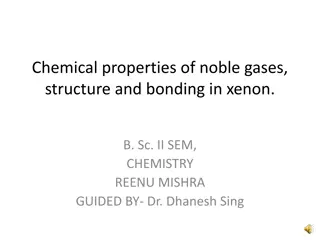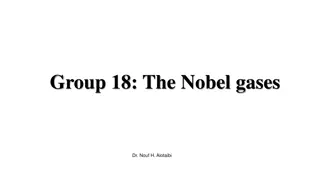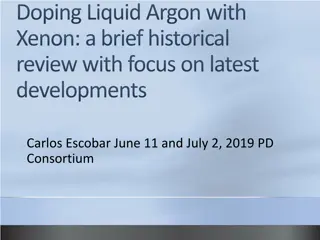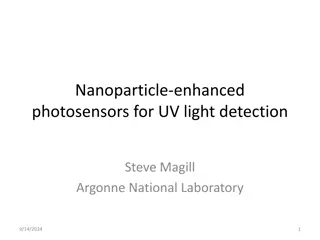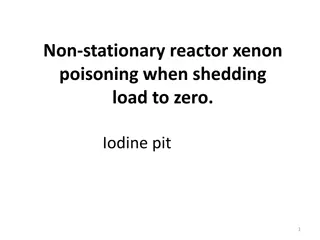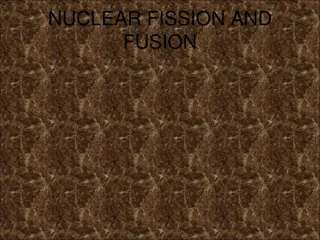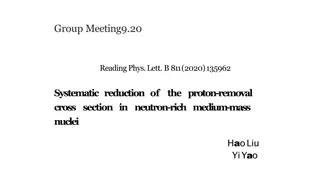Chemical Properties and Bonding in Xenon: A Study of Noble Gases
Noble gases, including xenon, exhibit unique chemical properties due to their stable electron configurations. Xenon forms compounds like xenon difluoride, xenon tetrafluoride, and xenon hexafluoride, showcasing various hybridization states and geometries. These compounds illustrate the reactivity of
0 views • 18 slides
The Noble Gases: Properties, Sources, and Uses
The noble gases, including helium, neon, argon, krypton, xenon, radon, and Oganesson, are characterized by their low reactivity due to a complete electron configuration. They have diverse applications, such as forming inert atmospheres, medical treatments, and lighting technologies. Naturally occurr
0 views • 16 slides
Advancements in Doping Liquid Argon with Xenon: Historical Overview
Delve into the historical review and latest developments of doping liquid argon with xenon, aiming to shift light wavelengths for improved visibility in TPC volumes. Key questions address the effect on scintillation components, stability of xenon doping, and potential ice cluster formation. Early st
0 views • 27 slides
Advances in Nanoparticle-Enhanced Photosensors for UV Light Detection and Quantum Confinement Research
Nanoparticle-enhanced photosensors are being developed by Steve Magill at Argonne National Laboratory for UV light detection, utilizing quantum confinement to enhance electronic and optical properties. Quantum confinement creates discrete energy levels in nanoparticles smaller than the electron wave
0 views • 30 slides
Exploring the Fascinating World of Chemical Elements Through Visuals
Dive into the captivating realm of chemical elements with this visual presentation, showcasing images and descriptions of elements like Antimony, Platinum, Silver, Radon, Strontium, Xenon, Tin, Mercury, Iodine, Tungsten, Tantalum, Barium, Gold, Lead, and Cesium. Each element is depicted in a unique
0 views • 16 slides
Reactor Xenon Poisoning and Iodine Pit Phenomenon
When a non-stationary reactor is shut down or its load is reduced to zero, xenon poisoning occurs due to the disruption of dynamic equilibrium between the increase and decrease of 135Xe. This leads to a temporary increase in 135Xe concentration, followed by a decrease as it decays. The reactivity ma
0 views • 58 slides
Understanding Nuclear Fission: Process, Examples, and Energy Generation
Nuclear fission involves the splitting of an atomic nucleus, with uranium-235 being a commonly used fissile material. When uranium-235 undergoes fission, it produces fission fragments, neutrons, gamma radiation, and kinetic energy. The fission process can be initiated by absorbing a slow-moving neut
0 views • 19 slides
Inter-Comparison Exercise on Nuclear Explosion Signal Screening
The 1st Nuclear Explosion Signal Screening Open Inter-Comparison Exercise in 2021 involved participants from various institutions worldwide to evaluate the detection power of anomalous measurements related to nuclear explosions. The exercise included processing a test data set with different scenari
0 views • 16 slides
Systematic Reduction of Proton-Removal Cross Section in Neutron-Rich Medium-Mass Nuclei
Single-nucleon knock-out reactions in neutron-rich medium-mass nuclei were studied to investigate the reduction of proton-removal cross section. Short-range correlated nucleon pairs, especially protons, were found to impact the probability of single-proton removal processes. Experimental measurement
0 views • 8 slides
